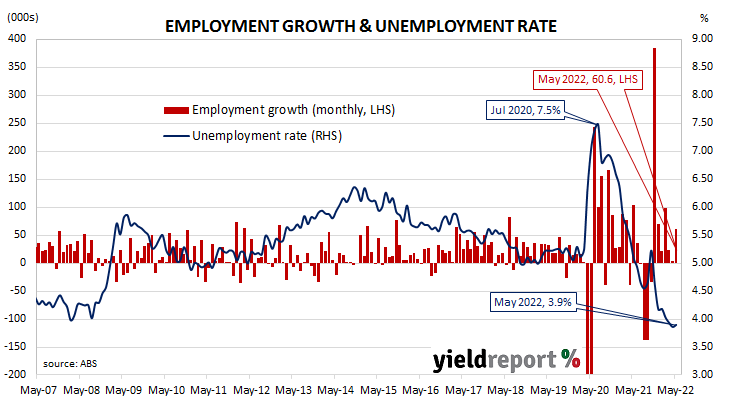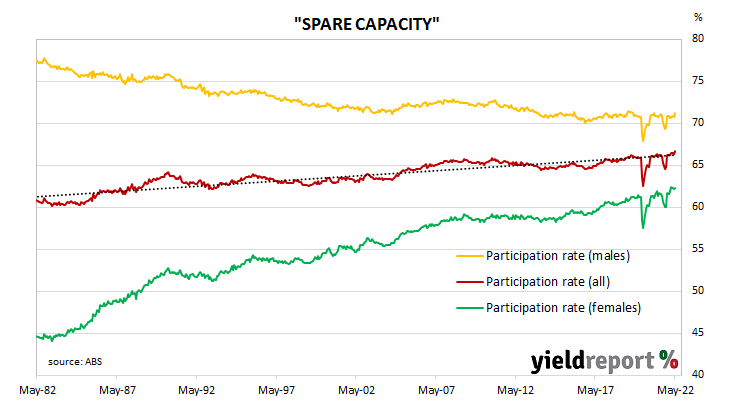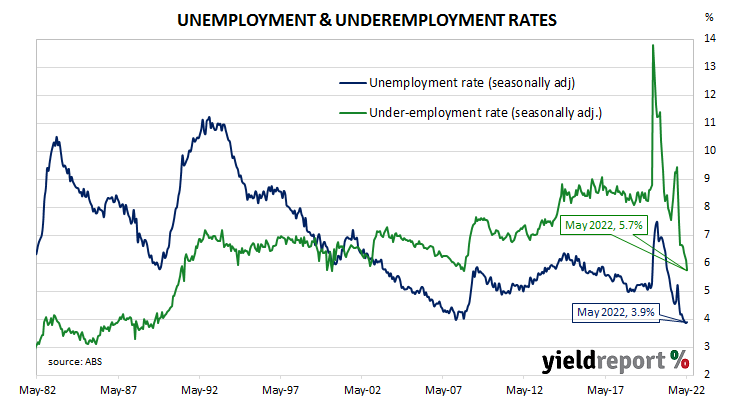Summary: Employment up 60,600 in May, more than expected; jobless rate steady at 3.9%, masks “a lot of strength elsewhere” in data; participation rate at new high; jobless rate steady at 3.9% after revisions; fewer part-time, more full-time jobs; aggregate work hours up 0.9%; underemployment rate down from 6.1% to 5.7%.
Australia’s period of falling unemployment came to an end in early 2019 when the jobless rate hit a low of 4.9%. It then averaged around 5.2% through to March 2020, bouncing around in a range from 5.1% to 5.3%. Leading indicators such as ANZ’s Job Ads survey and NAB’s capacity utilisation estimate suggested the unemployment rate would rise in the June 2020 quarter and it did so, sharply. The jobless rate peaked in July 2020 but fell below 7% a month later and has since trended lower.
The latest Labour force figures have now been released and they indicate the number of people employed in Australia according to ABS definitions increased by 60,600 in May. The rise was greater than the 25,000 increase which had been generally expected as well as April’s 4,500 increase.
“Australia’s unemployment rate was steady at 3.9% in May but this masked a lot of strength elsewhere in the data,” said ANZ senior economist Catherine Birch.
Domestic Treasury bond yields fell heavily on the day, generally following the movements of US Treasury bond yields in overnight trading. By the close of business, the 3-year ACGB yield had shed 22bps to 3.79%, the 10-year yield had lost 21bps to 4.07% while the 20-year yield finished 18bps lower at 4.26%.
In the cash futures market, expectations of a steeper path for the actual cash rate over time softened. At the end of the day, contracts implied the cash rate would rise from the current rate of 0.81% to 1.305% in July and then increase to 1.92% by August. November contracts implied a 3.385% cash rate while May 2023 contracts implied 4.29%.
“This robust update keeps in place a pathway to our forecast low in unemployment of 3.2%, though we are closely watching to see just how far participation can rise and other signs we might be hitting full employment,” said Westpac senior economist Justin Smirk.
The participation rate increased to 66.7% from April’s revised figure of 66.4% as the total available workforce increased by 62,100 to 14.059 million. However, the number of unemployed persons also increased by 7,800 to 548,100. As a result, the unemployment rate remained steady at 3.9% after revisions as the higher jobless number was offset by a larger number of people in the workforce.
The aggregate number of work hours across the Australian economy increased as 8,700 residents lost part-time positions and 69,400 residents gained full-time positions. In percentage terms, the total number of work hours rose by 0.9% after increasing by 1.3% in April. On a 12-month basis and after revisions, aggregate hours worked increased by 2.1% as 87,900 fewer people held part-time positions and 474,100 more people held full-time positions than in May 2021.
In recent years, more attention has been paid to the underemployment rate, which is the number of people in work but who wish to work more hours than they do currently. May’s underemployment rate dropped from 6.1% to 5.7%.
The underutilisation rate, that is the sum of the underemployment rate and the unemployment rate, has a strong correlation with the annual growth rate of the ABS private sector wage index when advanced by one quarter. May’s underutilisation rate of 9.6% corresponds with an annual growth rate of about 4.5%.




